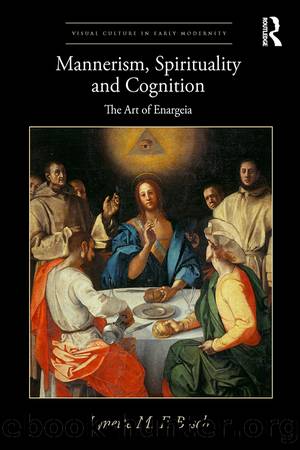Mannerism, Spirituality and Cognition (Visual Culture in Early Modernity) by Bosch Lynette M. F

Author:Bosch, Lynette M. F. [Bosch, Lynette M. F.]
Language: eng
Format: epub
Publisher: Taylor and Francis
Published: 2020-01-22T16:00:00+00:00
5 Maniera
A history
‘Mannerism was not born in any one specific country,’ said Jacques Bousquet 1 and in this book’s first chapter, it is argued that Mannerism’s origins are diverse and multinational. As Marco Treves noted, maniera has had many varied meanings across time and place, many were already in use before maniera was employed by Giorgio Vasari. … It should be borne in mind that, as the new meanings appeared, the old ones were not discarded, so that multiple meanings can occur in the same texts.’ 2 This chapter traces how Mannerism’s and maniera ’s many origins and meanings were developed prior to maniera ’s emergence in Giorgio Vasari’s Vite, where he extolled maniera ’s bellezza and maniera ’s grazia , as forming part of God’s gifts to humanity, so that art could bring Nature to life as part of God’s plan for humanity’s salvation.
Any consideration of maniera and spirituality should begin, in 1941, with Marco Treves’s study of maniera ’s linguistic history, which stands as the benchmark linguistic analysis of the meaning of maniera . In this critical article, Treves traced maniera from its inception, in the Latin manus , to its varied uses and interpretation through the centuries. Treves was a linguist, who found refuge from WWII in New York City, where he studied with Erwin Panofsky and Walter Friedlaender at New York University’s Institute of Fine Arts. 3 Thus, his essay combined his knowledge of Art History with his linguistic expertise, when considering maniera ’s multifaceted and multivalent meanings, from the Middle Ages through the twentieth century.
Maniera ’s Latin root is manus 4 and manuarius – (a) used by hand. 5 This root allowed for later employment of maniera within the technical terminology of artistic manufacture. Peter Abelard (1079–1142) used maneries ( maneres , spring from) to mean genera (pl. of genus , groups with shared characteristics). 6 In this context, maneries had a meaning comparable to the Latin genus (indicative of group or origin or ancestry). 7 Maniera ’s French, counterpart – maneries – was used by St. Bernard of Clairvaux (1090–1153) 8 and by a successor of Abelard in the philosophical consideration of universals. 9 In the late twelfth/early thirteenth century, Uguccione di Pisa or Huguccio Pisanus (d. 1210), the grammarian and canon lawyer, who wrote the Magnae Derivationes (a history of etymologies), used maneries in a way similar to that of Bernard, Abelard, and William of Auxerre. In keeping with other Medieval authors, Uguccione wrote about groups, which have shared characteristics, identifying them as species and rerum maneries (things of same type or classification). 10
The employment of species and rerum maneries to indicate likeness enabled maniera ’s meaning to encompass: style, way, manner, type, and form. Because the meaning of species includes the taxonomic classification of visual phenomenae, maniera could also indicate, categories of the classification of appearance, such as show, beauty, and splendor. 11 Thus, the idea of linking species and rerum maneries to categories linked through similarity became part of the linguistic
Download
This site does not store any files on its server. We only index and link to content provided by other sites. Please contact the content providers to delete copyright contents if any and email us, we'll remove relevant links or contents immediately.
Ancient Worlds by Michael Scott(2622)
Savage Harvest by Carl Hoffman(1912)
The Monuments Men by Robert M. Edsel(1738)
Cain by Jose Saramago(1493)
The Apogee - Byzantium 02 by John Julius Norwich(1410)
A History of the World in 100 Objects by MacGregor Neil(1308)
The O. Henry Prize Stories 2014 by Laura Furman(1208)
The Unfinished Palazzo by Judith Mackrell(1141)
The Swerve by Greenblatt Stephen(1120)
The Lost Secrets of Maya Technology by James A. O'Kon(1088)
50 Art Ideas You Really Need to Know by Susie Hodge(1053)
Joan Miró by Joan Miró(1028)
4 3 2 1 by Paul Auster(1023)
Cain by Saramago José(1015)
A Piece of the World by Christina Baker Kline(991)
Heretics and Heroes by Thomas Cahill(984)
The Book of Ruby(966)
Raising Hell: A Concise History of the Black Arts and Those Who Dared to Practice Them by Robert Masello(951)
1484244826 by Unknown(900)
